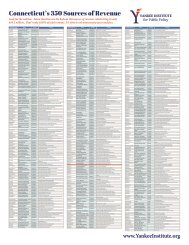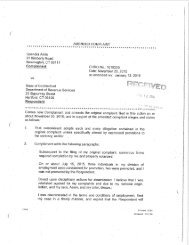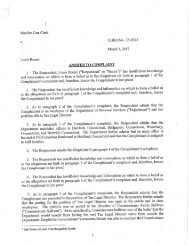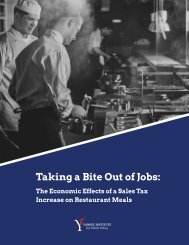Connecticut's Top Ten Business-Friendly Towns
Find out which Connecticut towns are truly open for business!
Find out which Connecticut towns are truly open for business!
Create successful ePaper yourself
Turn your PDF publications into a flip-book with our unique Google optimized e-Paper software.
Median income per household was selected over average income per capita or per household to better control for<br />
outliers and the unusually high Gini coefficient of many Connecticut towns.3 Municipalities with affluence spread<br />
broadly across their populations have strong middle classes that can support new and more intense economic<br />
activity. Meanwhile, the trends selected help to suggest the likely fate of the municipalities’ relative affluence.<br />
In Connecticut, job opportunities have been relatively scarce in recent years, prompting many residents to move<br />
out of state, retire or both. The decline of population in suburban and rural towns has created significant budget<br />
problems, causing fixed costs to rise relative to the number of remaining residents. This creates an impetus to<br />
raise and impose new taxes, which can then cause additional retirements and dislocation, raising the specter<br />
of a self-perpetuating vicious cycle of decay and decline. Lack of job opportunity also leads to workers of preretirement<br />
age leaving the workforce without moving out of state, which in many ways multiplies the problems<br />
already highlighted, as these residents both fail to contribute to the local economy and require a higher level of<br />
social-support services. The three-year trends are constructed by taking the percent change in total population,<br />
total population in the labor force, and unemployment between 2013 and 2016.<br />
For the economic vitality category, median household income accounted for 40 percent of the weight, acting as<br />
an anchor for the trend variables. The three-year changes in the labor force and in unemployment were weighted<br />
at 25 percent each, with changes in aggregate population accounting for the remaining 10 percent.<br />
Tax burden 20%<br />
Connecticut has a well-earned reputation for imposing extremely high tax burdens at both state and local levels.<br />
The majority of state taxes are on personal income, sales and corporate income, in descending order. Nearly all<br />
local revenue, meanwhile, comes from residential, commercial, commercial inventory and car property taxes.<br />
While other indices focus more narrowly on municipal sales and corporate income taxes, our index takes a more<br />
holistic approach by using total municipal tax burden per household, mill rate, and long-term obligation score,<br />
as defined in the “Warning Signs: Assessing Municipal Fiscal Health in Connecticut” study.<br />
Total taxes collected – as defined by the Connecticut Office of Policy and Management – divided by household<br />
is a rough estimate of the tax burden experienced at the municipal level. This figure aggregates the various types<br />
of property taxes, combining commercial and residential burdens. The aggregation of the tax burden is not<br />
accidental, as high residential taxes can reduce disposable income and suppress economic activity. Furthermore,<br />
attracting skilled, high-demand talent to a given area is much harder when residential taxes are high, forcing<br />
employers to offer premiums over their competitors in low-tax states.<br />
The per-household responsibility for all taxes levied, however, does not account for the relative ability of these<br />
households to carry their portion of the municipalities’ total tax bill. Therefore, our calculation of tax burden<br />
also considers the millage rates of the property taxes assessed by the community. Furthermore, each household’s<br />
ability to pay is partially captured by the economic vitality score through median household income.<br />
Unfunded pension liabilities have grown dramatically across the country since 2001 due to a mixture of asset<br />
underperformance and deferred or partial contributions to pension funds. In Connecticut, pensions never<br />
received proper annual funding until the 2010s, even at the state level, creating massive unfunded backlogs.<br />
Today, these unfunded liabilities have largely crippled state and municipal governments in Connecticut, as<br />
governments have run out of budget gimmicks to avoid inevitable debt-service and unfunded-liability payments.<br />
Residents experience either high taxes with subpar government services or even higher taxes and standard<br />
services.<br />
3 http://ctbythenumbers.info/2016/01/05/income-inequality-in-cts-4th-congressional-district-is-4th-largest-gap-in-nation-2nd-district-has-least-income-inequality-in-state/







